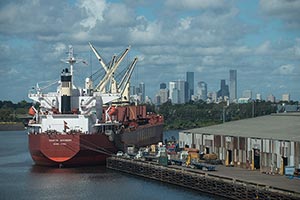Port of Houston Aims to be Distribution Hub for Center of Country

As trade through the Port of Houston grows, the city's ability to attract more cargo and keep its top ranking hinges on the infrastructure that keeps goods moving.
The opening of the Panama Canal's wider lane this summer and an anticipated boom in plastic production along the Houston Ship Channel will mean not just bigger ships steaming in, but also more trucks pounding the pavement and higher demand on the railroads.
Port of Houston Authority officials aim to make the city the distribution hub for the central U.S., from the Rocky Mountains to the Mississippi River. That means not just keeping the channel dredged and docks sturdy, but maintaining the roads and rail that carry lumber, steel, vegetables and shoes from around the world to towns and cities around the region.
"All of that is synchronized like music," said state Sen. Brandon Creighton, R-Conroe, who is chairing a new select committee to look at Texas ports' needs and economic impact. On Tuesday, April 12, he met with Port Authority and other local officials and toured the Bayport container terminal to learn about the Port of Houston.
"The biggest issues I think from the outset are gathering knowledge and fact-finding on: Do our port infrastructure and assets have what they need to keep up with demand?" he said. "With growth comes more and more demand on our infrastructure."
The Panama Canal expansion and anticipated growth in container trade have called more attention to keeping Texas competitive. The state's ports are critical in Texas' role as the nation's top exporter and energy center, particularly the Port of Houston, the largest in the country by tonnage.
Houston's port handled 165.5 million tons of cargo last year, and the equivalent of more than 2.1 million 20-foot-long containers. That trade relies on dredging waterways and maintaining the roads and railways that move goods to and from the water.
"We just want to make sure the state government understands how all these pieces fit together and the economic impact," Creighton said. "Do our roads need taller bridges? Do our waterways need deeper drafts?"
The Panama Canal's new lane will accommodate container ships that have continued to grow in recent years, chasing economies of scale. More container trade is expected as more natural gas processing plants - about $50 billion worth of projects - come online producing plastic for export.
This combination will bring hundreds of thousands more containers across Port Authority docks, chief commercial officer Ricky Kunz said on April 12. Much of the plastic resin will be shipped to Asia, increasing trade across the Pacific.
Trade with Asia already has been growing, and it now makes up nearly a third of the port's container trade. Port Authority docks handle almost all of container trade in Houston and the majority of containers along the Gulf Coast.
Port Authority Executive Director Roger Guenther emphasized how the committee can help ensure that the state maintains port infrastructure and the surrounding roads and rail.
"We have to work together to make sure this freight can move efficiently to its destination, and that's going to take all modes of transportation," he said.
"If you consider the exponential growth in truck traffic, that's why we are so concerned" about the surrounding infrastructure, port commission Chairwoman Janiece Longoria said.
Many port officials and those in the trucking industry worry about truck weight regulations limiting trade, and plan to advocate that the Legislature raise the limits to stay competitive with other states.
Dredging is also a perennial question. The Port Authority has paid for dredging that was eligible for federal funding because it did not want to wait to go through the long process with the coming expansion of the Panama Canal. It's also chipping in as the U.S. Army Corps of Engineers begins to survey the Houston Ship Channel for its next round of Dredging.
Lt. Gov. Dan Patrick announced the initiative for the select committee in Houston in October as a way to give the ports more attention.
"We haven't put the focus on them that we should when you consider the economic impact that they have," he said.
Patrick cited $277 billion in economic impact in Texas from its ports, and said he wanted the state to be more proactive in supporting them and the roads and railways that buttress them.
Texas ports need to be ready to take advantage of opportunities to grow when the Panama Canal expansion is completed, Patrick said.

